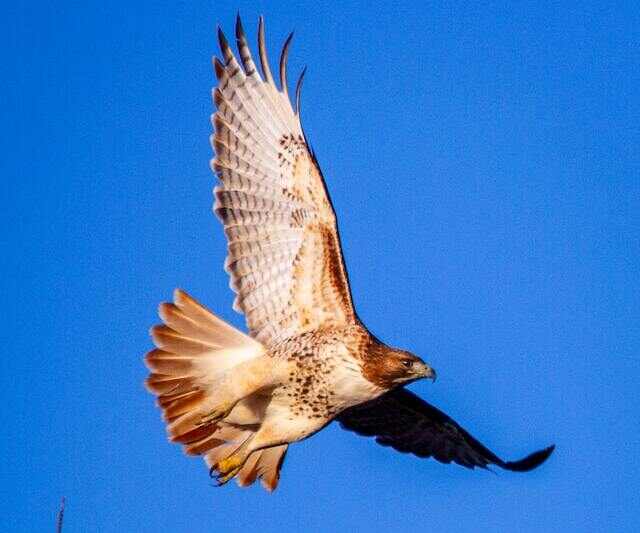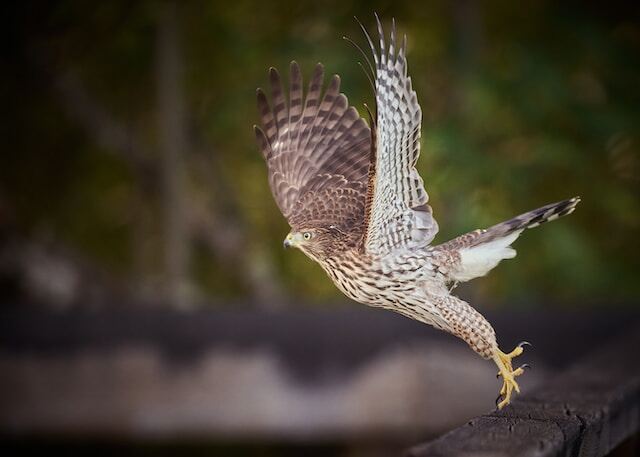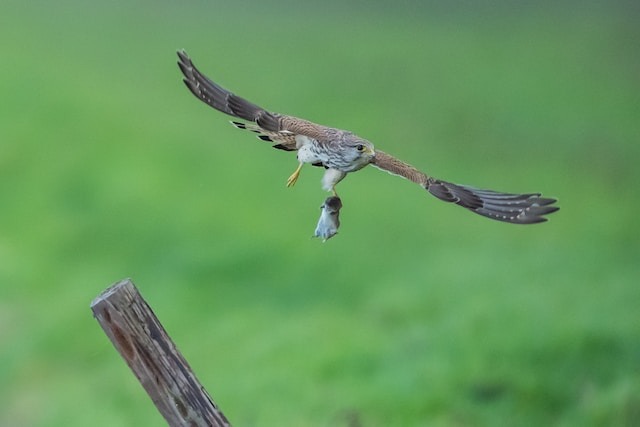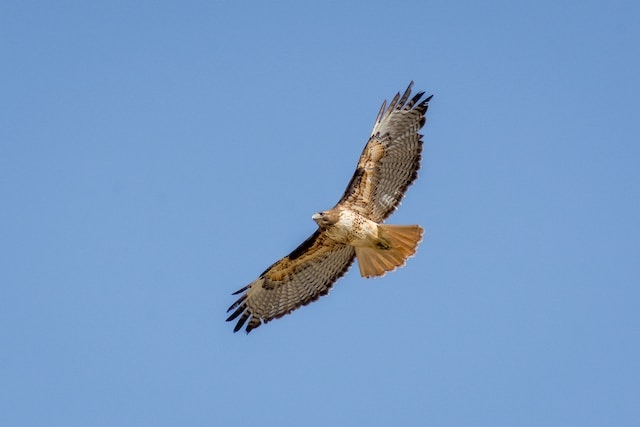Welcome to “Hawks Unveiled,” where we embark on a captivating journey into the skies alongside these majestic predators. In this series, we dive deep into the enigmatic world of hawks, seeking to uncover the secrets behind their remarkable aerial prowess.
From their graceful soaring techniques to the intricate mechanics of flight, join us as we unravel the mysteries of hawk mastery and gain a newfound appreciation for these extraordinary birds of prey.
Table of Contents
- 1 Key Takeaways
- 2 How Do Hawks Fly?
- 3 Physical Characteristics of Hawks
- 4 Anatomy of Hawk Wings
- 5 Aerodynamics of Hawk Flight
- 6 Flight Speed and Agility
- 7 Migration and Navigation
- 8 Hawks in the Ecosystem
- 9 Comparison to Other Birds of Prey
- 10 Frequently Asked Questions
- 11 Conclusion and Future Research
- 12 Author
Key Takeaways
- Hawks have physical adaptations such as broad wingspan, powerful talons, and exceptional eyesight, which allow them to hunt effectively.
- Hawks utilize gliding and soaring techniques to conserve energy and can fly at speeds up to 120 miles per hour.
- Hawks play a critical role in maintaining the balance of their ecosystem as top predators, but are threatened by human interference and require conservation efforts.
- The study of hawk flight can provide valuable insights for future innovation in aviation and engineering, including the use of biomimicry.
How Do Hawks Fly?
Hawks fly using a combination of strong wing muscles, specialized feathers, and aerodynamic techniques. They generate lift by flapping their wings and adjusting their wing shape for optimal airflow.
Hawks also utilize thermals and updrafts for soaring, conserving energy during long flights. Their keen vision helps them spot prey from high altitudes.
Hawks are skilled hunters and their flight abilities allow them to maneuver with speed, agility, and precision while pursuing and capturing their prey.
Physical Characteristics of Hawks
The physical characteristics of hawks, such as their broad wingspan and powerful talons, enable them to soar through the air and hunt with precision.
Hawks possess exceptional eyesight, which allows them to spot prey from great distances. Their sharp talons provide a strong grip on prey, while their hooked beaks help them tear flesh apart.
Hawks are able to hover in mid-air by flapping their wings rapidly and then glide seamlessly through the air, making them incredibly efficient hunters.
However, their unique hunting techniques are also due to the anatomy of their wings, which we will explore in the next section.
Anatomy of Hawk Wings
Regarding the anatomy of hawk wings, it is noteworthy that the primary feathers are the longest and most important for flight, comprising about 50% of the wing’s surface area.
The wing structure of hawks is characterized by strong and flexible bones that allow them to adjust the shape of their wings to suit their flight needs.
The feathers of hawk wings are adapted to provide lift and control during flight.
The feathers on the leading edge of the wing are slanted forward to reduce drag, while the feathers on the trailing edge are slanted backward to increase lift.
The shape and orientation of the feathers create a smooth and stable airflow over the wings, enabling hawks to perform their impressive aerial acrobatics.
Understanding the feather adaptations and wing structure of hawks is crucial to understanding how they are able to fly with such grace and precision.
This knowledge is also essential to understanding the aerodynamics of hawk flight, which we will explore in the subsequent section.

Aerodynamics of Hawk Flight
The aerodynamics of hawk flight is a complex and fascinating topic that involves a number of key factors.
One of the most important of these is the interplay between lift and drag forces, which determine how the hawk is able to stay aloft.
In addition, the angle of attack and airflow around the wings play a critical role in determining the hawk’s flight characteristics, while the use of glide and soaring techniques helps the bird conserve energy and travel long distances.
Lift and Drag Forces
One important aspect of the flight of hawks is the interaction between lift and drag forces. These forces are crucial in determining the efficiency and optimization of their flight.
Hawks are known for their long migratory journeys, and the lift and drag forces play a significant role in their ability to navigate through different environments.
The lift force is generated by the air pressure difference between the top and bottom of the hawk’s wings, whereas the drag force is caused by the resistance of air molecules hitting the surface of the wings.
Hawks are able to adjust the angle of their wings to optimize the lift-to-drag ratio, which allows them to fly for longer distances with less effort.
Understanding the lift and drag forces is critical in studying the flight patterns of hawks and other birds.
The next section explores how the angle of attack and airflow contribute to hawk flight, building on our understanding of lift and drag forces.
Angle of Attack and Airflow
Optimizing the angle of attack and airflow is essential for maximizing lift and minimizing drag, which facilitates efficient flight in hawks and other birds.
To analyze the physics of this phenomenon, researchers use experimental methods for studying the airflow around bird wings.
These methods include wind tunnels, computational simulations, and high-speed cameras.
The angle of attack, or the angle between the wing’s chord and the relative wind, determines the lift produced by the wing.
A higher angle of attack generates more lift but also more drag. In contrast, a lower angle of attack creates less lift but also less drag.
The airflow, or the movement of air around the wing, also affects the lift and drag forces. The airflow separates from the wing at high angles of attack, leading to a stall and loss of lift.
In contrast, smooth and laminar airflow over the wing surface produces the maximum lift and minimum drag.
Therefore, hawks and other birds adjust their wings’ angle of attack and the airflow over their wings to maintain efficient flight.
Transitioning to the subsequent section on glide and soaring techniques, birds use their wings’ unique shape, size, and structure to optimize their flight performance.
Glide and Soaring Techniques
Glide and soaring techniques in birds are optimized through the unique shape, size, and structure of their wings.
Glide is a technique where birds use the air currents to move forward without flapping their wings.
Soaring, on the other hand, involves birds using updrafts or thermal currents to gain altitude without expending energy.
To conserve energy, birds use a combination of both techniques to travel long distances.
The key to successful gliding and soaring is to minimize drag and maximize lift, which is achieved by adjusting the shape of their wings.
For example, hawks have long, narrow wings that are tapered at the tip to reduce drag and increase lift. Additionally, hawks use their tail feathers to steer and adjust their angle of attack during flight.
By using these energy conservation strategies, hawks are able to fly for long periods without expending too much energy.
Moving forward, understanding how hawks use their wings to achieve efficient gliding and soaring will provide insight into their flight speed and agility.

Flight Speed and Agility
The flight speed and agility of hawks allow them to efficiently hunt and capture prey in a variety of environments.
Hawks are known for their impressive flight patterns and hunting strategies, which involve quick turns, sudden stops, and agile movements.
Hawks can fly at speeds up to 120 miles per hour, making them one of the fastest birds in the world.
Their wings are designed to allow for quick and precise movements, which is essential for capturing prey. Hawks also have excellent vision, which enables them to spot prey from great distances.
To understand the flight speed and agility of hawks, we can look at a table that outlines their physical characteristics.
The table below shows the average measurements of the wingspan, weight, and speed of several species of hawks:
| Species | Wingspan (inches) | Weight (pounds) | Speed (mph) |
|---|---|---|---|
| Cooper’s | 30-36 | 0.5-1.0 | 40-55 |
| Red-tailed | 44-52 | 1.5-3.0 | 120 |
| Sharp-shinned | 20-27 | 0.2-0.4 | 25-40 |
Overall, the flight speed and agility of hawks are essential for their survival and success as hunters. In the next section, we will explore how hawks navigate and migrate long distances.
Migration and navigation are critical components of a hawk’s life cycle, as they must travel long distances to find suitable habitats and prey.
Hawks have developed remarkable abilities to navigate through the use of environmental cues such as the position of the sun and magnetic fields.
They can also use landmarks, such as mountain ranges and coastlines, to orient themselves. Additionally, hawks are capable of using their sense of smell to locate food and navigate through unfamiliar territory.
However, the effects of climate change have impacted the migration patterns of some hawk species, causing them to alter their routes and timing.
Evolutionary adaptations have also played a role in the navigation and migration of hawks, with some species developing wider wingspans and more efficient flight capabilities to cover greater distances.
Understanding the complexities of hawk migration and navigation is crucial for their survival, as it enables conservation efforts to be put in place to protect their habitats and ensure their continued existence.
Next, we will explore the role of hawks in the ecosystem.

Hawks in the Ecosystem
Predatory birds such as hawks play an important role in the ecosystem by controlling the populations of smaller animals, thus maintaining a balance in the food chain.
As top predators, hawks are crucial to the health and stability of their ecosystem. They are known for their impressive hunting skills, which enable them to capture various prey animals such as rodents, reptiles, and other birds.
Hawks are also highly adaptable and can thrive in a variety of environments, from forests to deserts. However, human interference has had a significant impact on the populations of hawks.
Habitat destruction, pollution, and hunting have all contributed to declines in hawk populations. As a result, conservation efforts are necessary to ensure the survival of these vital predators.
The table below depicts how hawks help to maintain balance in their ecosystems by controlling populations of smaller animals.
| Animals Hawks Prey Upon | How They Control Populations | Population Control Method |
|---|---|---|
| Rodents | Hunt and kill | Direct predation |
| Reptiles | Hunt and kill | Direct predation |
| Other Birds | Compete for resources | Indirect competition |
The impact of human activity on hawk populations emphasizes the need for a better understanding of the ecological role of these birds.
In the next section, we will compare hawks to other birds of prey, highlighting their unique characteristics and contributions to the ecosystem.
Comparison to Other Birds of Prey
Hawks are not the only birds of prey that exist in the ecosystem.
They share certain characteristics with other birds of prey such as eagles, falcons, and owls, but there are also some notable differences in their physical appearance, behavioral patterns, and hunting strategies.
To give the audience a clearer understanding, here are some comparisons between hawks and other birds of prey:
- Eagles are larger than hawks and have longer wingspans that allow them to soar at higher altitudes.
- Falcons are known for their speed and agility, which surpass that of hawks.
- Owls have a distinct facial disk that helps them locate prey in the dark, while hawks rely on their sharp vision during daylight hours.
- Hawks are known for their aerial prowess and hunting techniques, which involve diving at high speeds to catch their prey.
When it comes to behavioral patterns and hunting strategies, hawks are known to be solitary hunters that prefer open spaces where they can spot their prey from a distance.
They also have keen eyesight that allows them to spot prey from miles away, and they use their sharp talons to capture and kill their prey quickly.
In conclusion, while hawks share some similarities with other birds of prey, they have unique characteristics that distinguish them from their counterparts.
Future research may explore these differences further to better understand the role of hawks in the ecosystem.

Frequently Asked Questions
How do hawks mate and reproduce?
Hawks engage in elaborate courtship rituals, including aerial displays and vocalizations, before selecting a nesting site.
Females lay eggs in the nest, which are incubated for several weeks before hatching. Hatchlings are cared for by both parents until they fledge and leave the nest.
What is the lifespan of a hawk?
The lifespan of hawks varies depending on the species and factors such as habitat and food availability.
Hawks have developed survival techniques such as keen eyesight, speed, and agility to increase their chances of survival in their environment.
How do hawks communicate with each other?
Hawks communicate with each other through vocalizations and body language, using non-verbal cues and sounds.
Predatory behavior is key to understanding how they hunt and capture prey in the wild. Their communication is detailed, technical, and scientific, engaging those with a subconscious desire for freedom.
What is the diet of a hawk?
Hawks are carnivorous and their diet varies depending on their species and environmental factors.
They are opportunistic hunters, using their keen eyesight to locate prey before using their hunting techniques, such as aerial attacks or stalking, to capture it.
Their prey selection includes small mammals, birds, reptiles, and insects.
How do hawks interact with humans and human activities?
Hawks have adapted well to urbanization, often nesting on tall buildings. Human activity can negatively impact hawks, but rehabilitation programs help injured birds recover and return to the wild.

Conclusion and Future Research
In conclusion, this article has provided a thorough examination of the anatomy and aerodynamics of hawk flight.
While much is known about these birds of prey, there is still potential for further study and innovation in this field.
The implications of this research extend beyond the animal kingdom, with potential applications in aviation and engineering.
As such, continued research in this area will undoubtedly yield valuable insights and advancements.
Recap of Hawk Flight Anatomy and Aerodynamics
The intricate structure of a hawk’s wing allows it to efficiently soar through the air with grace and ease.
The primary feathers located at the tips of the wings are responsible for generating lift, while the secondary feathers provide stability and maneuverability.
The wingspan of a hawk is also crucial to its flight behavior, as a longer wingspan allows for more lift and a wider range of motion.
Environmental factors such as wind patterns and air currents can greatly affect a hawk’s flight, as they are able to utilize these factors to conserve energy and travel long distances.
It is fascinating to consider the aerodynamics involved in hawk flight and the potential for further study and innovation in this field.
Potential for Further Study and Innovation
Recapping the anatomy and aerodynamics of hawk flight provides a solid foundation for understanding the potential for further study and innovation.
By examining the unique adaptations and techniques that allow hawks to soar through the skies, we can identify potential applications and limitations for engineering and aviation.
One way to explore these possibilities is through the use of a table that compares the flight characteristics of hawks with those of aircraft.
Such a table could include categories such as lift generation, energy efficiency, maneuverability, and speed, providing a clear visual representation of the similarities and differences between biological and engineered flight.
However, there are also challenges to be considered. For example, while hawks can soar effortlessly for hours, aircraft require fuel and maintenance.
Additionally, hawks are adapted to specific environments and may not be able to perform as well in other locations or under different conditions.
Nonetheless, the potential for innovation and study is vast, and we can look forward to exploring new methods of flight inspired by the natural world.
This has significant implications for aviation and engineering, as we continue to push the boundaries of what is possible in the skies.
Implications for Aviation and Engineering
Comparing the flight characteristics of hawks with those of aircraft can provide a clear visual representation of the similarities and differences between biological and engineered flight, which has significant implications for aviation and engineering.
Bio-inspired design has already been used to create innovative and efficient solutions, such as winglets inspired by bird feathers.
By studying the flight of hawks, engineers can gain insights into how to improve the performance of aircraft, including reducing drag and increasing lift.
Additionally, hawk-inspired drones have been developed for a variety of applications, such as wildlife monitoring, search and rescue operations, and military surveillance.
The use of biomimicry in engineering can not only lead to more efficient and effective designs, but also has the potential to reduce environmental impact.
As the demand for sustainable solutions continues to grow, the study of hawk flight can provide valuable insights for future innovation in aviation and engineering.




